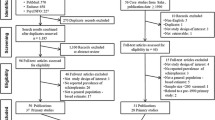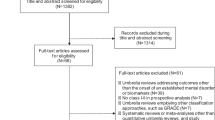Abstract
Objective
To review the last thirty years of studies that, using Swedish population registers, have added to our understanding of the aetiology of schizophrenia
Sample Included/Methods
A literature search was performed to systematically review all studies that using Swedish Population based registers have investigated the aetiology of schizophrenia. Key authors in the field, predominately from Swedish institutions, were additionally contacted and key journals hand searched, for missing references. A quality assessment methodological review was then conducted on each study. Data was extracted and tabulated on identified aetiological themes
Results
61 articles were included corresponding to 10 identified aetiological themes. Although the majority of included studies were retrospective cohort studies, case control studies were also included where they used population based registers. Confirming previous research, schizophrenia was found to have a multi-factorial aetiological basis with pregnancy and birth factors, parental age, social adversity, genetics, substance misuse, migration and ethnicity, personality, non-psychiatric co-morbidity, psychiatric history and poor cognitive performance all found to be significantly associated with an increased risk of later schizophrenia.
Conclusions
Although some difficulties exist in analysing the interplay between each of these factors, the Swedish population registers have added considerably to our understanding of each of the presented individual aetiological themes. The ability to study the whole population over several decades has been particularly useful in determining the timing of exposures.

Similar content being viewed by others
Notes
Body Mass Index.
References
World Health Organisation (2015) Schizophrenia
Knapp M, Mangalore R, Simon J (2004) The global costs of schizophrenia. Schizophrenia Bull 30(2):279–293
White E, Hunt JR, Casso D (1998) Exposure measurement in cohort studies: the challenges of prospective data collection. Epidemiol Rev 20(1):43–56
Wells GA, Shea B, O’Connell D, Peterson J, Welch V, Losos M, Tugwell P (2010) The Newcastle-Ottawa Scale (NOS) for assessing the quality of nonrandomised studies in meta-analyses. http://www.ohri.ca/programs/clinical_epidemiology/oxford.asp
Hultman CM et al (1999) Prenatal and perinatal risk factors for schizophrenia, affective psychosis, and reactive psychosis of early onset: case-control study. BMJ Br Med J 318(7181):421–426
Gunnell D et al (2003) Patterns of fetal and childhood growth and the development of psychosis in young males: a cohort study. Am J Epidemiol 158(4):291–300
Nilsson E et al (2005) Fetal growth restriction and schizophrenia: a Swedish twin study. Twin Res Hum Genet 8(4):402–408
Abel KM et al (2010) Birth weight, schizophrenia, and adult mental disorder: is risk confined to the smallest babies? Arch Gen Psychiatry 67(9):923–930
Gunnell D et al (2005) The association of fetal and childhood growth with risk of schizophrenia. Cohort study of 720,000 Swedish men and women. Schizophrenia Res 79(2):315–322
Nosarti C et al (2012) Preterm birth and psychiatric disorders in young adult life. Arch Gen Psychiatry 69(6):610–617
Dalman C et al (1999) Obstetric complications and the risk of schizophrenia: a longitudinal study of a national birth cohort. Arch Gen Psychiatry 56(3):234–240
Gunawardana L et al (2011) Pre-conception inter-pregnancy interval and risk of schizophrenia. Br J Psychiatry 199(4):338–339
Fouskakis D et al (2004) Is the season of birth association with psychosis due to seasonal variations in foetal growth or other related exposures? a cohort study. Acta Psychiatr Scand 109(4):259–263
Svensson E et al (2013) Schizophrenia susceptibility and age of diagnosis—a frailty approach. Schizophrenia Res 147(1):140–146
Karlsson H et al (2012) Maternal antibodies to dietary antigens and risk for nonaffective psychosis in offspring. Am J Psychiatry 169(6):625–632
Class QA et al (2014) Offspring psychopathology following preconception, prenatal and postnatal maternal bereavement stress. Psychol Med 44(1):71–84
Stalberg K et al (2007) Prenatal ultrasound scanning and the risk of schizophrenia and other psychoses. Epidemiology 18(5):577–582
Dalman C et al (2001) Signs of asphyxia at birth and risk of schizophrenia. Population-based case-control study. Br J Psychiatry 179:403–408
Dalman C, Allebeck P (2002) Paternal age and schizophrenia: further support for an association. Am J Psychiatry 159(9):1591–1592
Zammit S et al (2003) Paternal age and risk for schizophrenia. Br J Psychiatry 183:405–408
Sipos A et al (2004) Paternal age and schizophrenia: a population based cohort study. BMJ 329(7474):22
Frans EM et al (2011) Advanced paternal and grandpaternal age and schizophrenia: a three-generation perspective. Schizophrenia Res 133(1–3):120–124
Svensson AC et al (2012) Familial aggregation of schizophrenia: the moderating effect of age at onset, parental immigration, paternal age and season of birth. Scand J Public Health 40(1):43–50
Ekeus C, Olausso PO, Hjern A (2006) Psychiatric morbidity is related to parental age: a national cohort study. Psychol Med 36(2):269–276
Ek M et al (2014) Advancing paternal age and schizophrenia: the impact of delayed fatherhood. Schizophr Bull: First published online 4 Nov 2014. doi:10.1093/schbul/sbu154
Ek M et al (2012) Adoptive paternal age and risk of psychosis in adoptees: a register based cohort study. PLoS ONE 7(10):e47334
Wicks S et al (2005) Social adversity in childhood and the risk of developing psychosis: a national cohort study. Am J Psychiatry 162(9):1652–1657
Wicks S, Hjern A, Dalman C (2010) Social risk or genetic liability for psychosis? a study of children born in Sweden and reared by adoptive parents. Am J Psychiatry 167(10):1240–1246
Hjern A, Wicks S (2004) Dalman C (2004) Social adversity contributes to high morbidity in psychoses in immigrants–a national cohort study in two generations of Swedish residents. Psychol Med 34(6):1025–1033
Westman J, Johansson LM, Sundquist K (2006) Country of birth and hospital admission rates for mental disorders: a cohort study of 4.5 million men and women in Sweden. Eur Psychiatry 21(5):307–314
Lewis G et al (1992) Schizophrenia and city life. Lancet 340(8812):137–140
Zammit S et al (2010) Individuals, schools, and neighborhood: a multilevel longitudinal study of variation in incidence of psychotic disorders. Arch Gen Psychiatry 67(9):914–922
Sariaslan A et al (2014) Does population density and neighborhood deprivation predict schizophrenia? a nationwide Swedish family-based study of 2.4 million individuals. Schizophr Bull, Advance access, published online 22 July 2014: doi:10.1093/schbul/sbu105
Sundquist K et al (2008) Subsequent risk of hospitalization for neuropsychiatric disorders in patients with rheumatic diseases: a nationwide study from Sweden. Arch Gen Psychiatry 65(5):501–507
Lichtenstein P et al (2006) Recurrence risks for schizophrenia in a Swedish national cohort. Psychol Med 36(10):1417–1425
Lichtenstein P et al (2009) Common genetic determinants of schizophrenia and bipolar disorder in Swedish families: a population-based study. Lancet 373:234–239
Larsson H et al (2013) Risk of bipolar disorder and schizophrenia in relatives of people with attention-deficit hyperactivity disorder. Br J Psychiatry 203:103–106
Ludvigsson JF et al (2007) Coeliac disease and risk of schizophrenia and other psychosis: a general population cohort study. Scand J Gastroenterol 42(2):179–185
Cederlöf M et al (2014) The association between Darier disease, bipolar disorder, and schizophrenia revisited: a population-based family study. Bipolar disorders
Johansson V et al (2014) Multiple sclerosis and psychiatric disorders: comorbidity and sibling risk in a nationwide Swedish cohort. Mult Scler 20(14):1881–1891
David A et al (1995) Are there neurological and sensory risk factors for schizophrenia? Schizophr Res 14(3):247–251
Fors A et al (2013) Hearing and speech impairment at age 4 and risk of later non-affective psychosis. Psychol Med 43(10):2067–2076
Zammit S et al (2007) Height and body mass index in young adulthood and risk of schizophrenia: a longitudinal study of 1,347,520 Swedish men. Acta Psychiatr Scand 116(5):378–385
Harrison G et al (2006) Risk of schizophrenia and other non-affective psychosis among individuals exposed to head injury: case control study. Schizophr Res 88(1–3):119–126
Andreasson S et al (1987) Cannabis and schizophrenia. A longitudinal study of Swedish conscripts. Lancet 2(8574):1483–1486
Andreasson S, Allebeck P, Rydberg U (1989) Schizophrenia in users and nonusers of cannabis. A longitudinal study in Stockholm County. Acta Psychiatr Scand 79(5):505–510
Allebeck P et al (1993) Cannabis and schizophrenia: a longitudinal study of cases treated in Stockholm County. Acta Psychiatr Scand 88(1):21–24
Zammit S et al (2002) Self-reported cannabis use as a risk factor for schizophrenia in Swedish conscripts of 1969: historical cohort study. BMJ 325(7374):1199
Manrique-Garcia E et al (2012) Cannabis, schizophrenia and other non-affective psychoses: 35 years of follow-up of a population-based cohort. Psychol Med 42(6):1321–1328
Giordano GN et al (2015) The association between cannabis abuse and subsequent schizophrenia: a Swedish national co-relative control study. Psychol Med 45(02):407–414
Andreasson S, Allebeck P (1991) Alcohol and psychiatric illness: longitudinal study of psychiatric admissions in a cohort of Swedish conscripts. Int J Addict 26(6):713–728
Lewis G et al (2000) Non-psychotic psychiatric disorder and subsequent risk of schizophrenia. Cohort study. Br J Psychiatry 177:416–420
Giordano GN et al (2014) The association between cannabis abuse and subsequent schizophrenia: a Swedish national co-relative control study. Psychol Med 3:1–8 (online)
Harrison G et al (2003) Association between psychotic disorder and urban place of birth is not mediated by obstetric complications or childhood socio-economic position: a cohort study. Psychol Med 33(4):723–731
Leao TS et al (2006) Incidence of schizophrenia or other psychoses in first- and second-generation immigrants: a national cohort study. J Nerv Ment Dis 194(1):27–33
Malmberg A et al (1998) Premorbid adjustment and personality in people with schizophrenia. Br J Psychiatry 172:308–313
Zammit S et al (2010) Examining interactions between risk factors for psychosis. Br J Psychiatry 197(3):207–211
Song J et al (2014) Bipolar disorder and its relation to major psychiatric disorders: a family-based study in the Swedish population. Bipolar Disord 13(10):12242
Zammit S et al (2004) A longitudinal study of premorbid IQ Score and risk of developing schizophrenia, bipolar disorder, severe depression, and other nonaffective psychoses. Arch Gen Psychiatry 61(4):354–360
David AS et al (1997) IQ and risk for schizophrenia: a population-based cohort study. Psychol Med 27(06):1311–1323
Gunnell D et al (2002) Associations between premorbid intellectual performance, early-life exposures and early-onset schizophrenia. Cohort study. Br J Psychiatry 181:298–305
MacCabe JH, Lambe MP, Cnattingius S, Torrång A, Björk C, Sham PC, David AS, Murray RM, Hultman CM (2008) Scholastic achievement at age 16 and risk of schizophrenia and other psychoses: a national cohort study. Psychol Med 38(8):1133–1140
MacCabe JH et al (2013) Decline in cognitive performance between ages 13 and 18 years and the risk for psychosis in adulthood: a Swedish longitudinal cohort study in males. JAMA Psychiatry 70(3):261–270
Dalman C et al (2002) Young cases of schizophrenia identified in a national inpatient register. Soc Psychiatry Psychiatric Epidemiol 37(11):527–531
Conflict of interest
On behalf of all the authors, the corresponding author states that there is no conflict of interest.
Author information
Authors and Affiliations
Corresponding author
Electronic supplementary material
Below is the link to the electronic supplementary material.
Rights and permissions
About this article
Cite this article
Harper, S., Towers-Evans, H. & MacCabe, J. The aetiology of schizophrenia: what have the Swedish Medical Registers taught us?. Soc Psychiatry Psychiatr Epidemiol 50, 1471–1479 (2015). https://doi.org/10.1007/s00127-015-1081-7
Received:
Accepted:
Published:
Issue Date:
DOI: https://doi.org/10.1007/s00127-015-1081-7




